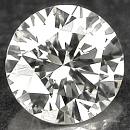|
|
|
|
Click on a letter above to view the list of gems. |
|
|
|
|
|
Diamond |
|
| Chemistry: C [Carbon] | |
| Discovered
in Prehistory;
IMA
status: Valid (pre-IMA; Grandfathered). | ||
|
| ||
|
Classification |
|
|
| |
|
Elements | |
|
1/B.02-40 | |
|
|
1 : ELEMENTS (Metals and intermetallic alloys; metalloids and
nonmetals; carbides, silicides, nitrides, phosphides) |
|
Related to: |
Native Elements. Carbon Series: Graphite - Lonsdaleite. Carbon - Silicon Family. Carbon Polymorph Group. |
|
|
|
|
Crystal Data |
|
|
|
|
|
Most commonly octahedral, crystals to 10 cm or more, also dodecahedral, tetrahedral, and cubic. Curved and striated faces common; spherical, with internal radial structure. |
|
|
Contact twins with {111} as twin plane; typically flattened on {111}; as penetration twins, may be repeated. |
|
|
|
|
|
Physical Properties |
|
|
|
|
|
[111] Perfect, [111] Perfect, [111] Perfect |
|
|
Conchoidal |
|
|
Brittle |
|
|
10.0 (Mohs hardness reference species) |
|
|
3.511 - 3.530 (g/cm3) |
|
|
Occassionally Fluorescent (Blue) and Phosphorescent; Triboelectric |
|
|
Not Radioactive |
|
|
Other: |
The highest thermal conductivity of any known substance. |
|
|
|
|
Optical Properties |
|
|
|
|
|
Colorless, pale Yellow to deep Yellow, Brown, White, Blue-White; less commonly in Oranges, Pinks, Greens, Blues, Reds, Gray to Black |
|
|
Transparent to Translucent |
|
|
Adamantine to Greasy |
|
|
2.4175 - 2.4178 Isotropic |
|
|
0.000 Isotropic |
|
|
Strong |
|
|
None |
|
|
Birefringent where strained |
|
|
|
|
|
Occurances |
|
|
|
|
|
Geological Setting: |
Primarily formed in pipes, less commonly in dikes, of deep-seated, igneous origin, composed of kimberlite or lamproite, and in alluvial deposits formed by their weathering. In carbonaceous achondrite and iron meteorites; may be formed by impact. |
|
Common Associations: |
Diopside, Forsterite, Ilmenite, Phlogopite, Pyrope, (kimberlite pipes); Anatase, Brookite, Garnet, Gold, Hematite, Ilmenite, Magnetite, Rutile, Topaz, Tourmaline, Zircon (placers) |
|
Type Locality: |
Unknown; Prehistoric |
|
Year Discovered: |
Unknown; Prehistoric |
|
View mineral photos: | |
|
|
|
|
More Information |
|
|
|
|
|
| |
|
|
|
|
Diamonds
are found in many locations worldwide. |
|
|
We
have not photographed our Diamond gems. Please
check back soon. |
